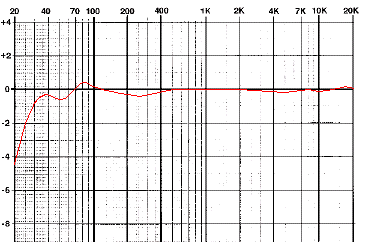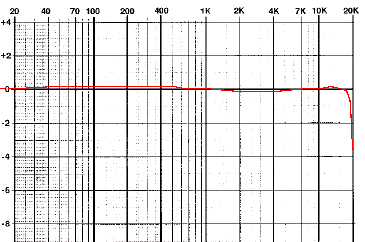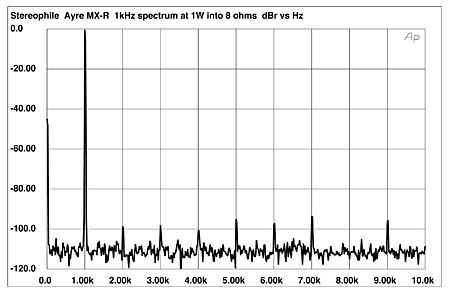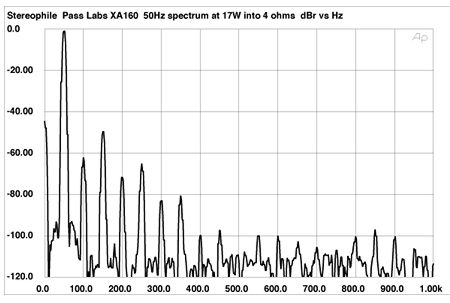You would pull anything out of thin air to make a point, isn't it?
Even with cheating, the number is ridiculously low. 😀
The tip o' the hat to John is Ed's use of 1968 components for examples, so even my numbers were enormously higher noise than you get from modern ICs.
Ampex ATR-102 half-inch two-track, (not modified by John curl 🙂 with extended low frequency heads, 30 IPS. This is at Studio X in Seattle.

And this a Pc based with Starmax MT3200 computer's onboard A/D converter

And this a Pc based with Starmax MT3200 computer's onboard A/D converter
What I like best is the 1966 voltage regulators made by National. They were quieter than almost anything, today!
To rephrase a point JC was making ---
1. The IC's neg feedback network is in parallel with its load Z ... giving a much lower Z than the input of the power amp would imply.
2. In order to obtain the noise level spec of the IC, it would need very low Z in the neg feedback network.
3. low Z feedback network reduces the max output in the spec sheet.
4. You cant get all the specs in one circuit with fixed values.
have I got that right, JC?
-Thx- RNMarsh
1. The IC's neg feedback network is in parallel with its load Z ... giving a much lower Z than the input of the power amp would imply.
2. In order to obtain the noise level spec of the IC, it would need very low Z in the neg feedback network.
3. low Z feedback network reduces the max output in the spec sheet.
4. You cant get all the specs in one circuit with fixed values.
have I got that right, JC?
-Thx- RNMarsh
This is a 48 KHz recording. Double the frequency for a 96, quadruple with a 192kHz, while i doubt you will hear any listening difference.Great bass with digital. Too bad about the higher frequencies.
May-be asking your dog on his paws crafted enclosures ?
What I like best is the 1966 voltage regulators made by National. They were quieter than almost anything, today!
Hear, hear, the golden 60's 😀.
Ever tried the TPS7A470 and it's negative version TPS7A3301? 16uV noise in 100KHz BW, one order of magnitude lower than the National 60's negative regulators. And 4uV for the positive version.
You yet knew all that very well, Richard 🙂4. You cant get all the specs in one circuit with fixed values
This said, we can notice that, when we need gain and low noise, we do not need high output levels and currents, and when we need current for output buffers, we do not have to care too much about gain or noise.
Oh, sorry, so you shifted the discussion from the 7815 here to a 7915, known as having a much worse frequency response. Good to know.
Still, the rest doesn't make much sense. But the 7915 has it's own noise of 175uV in 100KHz BW, much larger than those 26uV coming from that so-called "ripple" @3KHz. Plus that we have something called "decoupling".
You would pull anything out of thin air to make a point, isn't it?
175uV wide band doesn't tell one what it is weighted
We were talking about the effect of ripple and PSSR. You brought in regulators. In a preamp you have two supply rails. It is the negative rail that is the worst. So that is the one to analyze.
Now if you have your own measurements to show do so. I have shown a few of mine.
Among the other real world issues is that SY's .1 farad capacitor will be less effective at 6k! Then there is the issue of the voltage drop across the regulator and how the trade off between power dissipation and lower ripple
But do come back when you can recognize the definition of capacitance.
Back to the Evil's 7th. We know whom JC considers as great audio designers. So -
Ayre MX-R, 1W/8ohm

The 7th is the highest o all FFT components.
Pass XA160 17W/4ohm

The 7th is pretty high.
So?
Ayre MX-R, 1W/8ohm

The 7th is the highest o all FFT components.
Pass XA160 17W/4ohm

The 7th is pretty high.
So?
Even with cheating, the number is ridiculously low. 😀
The tip o' the hat to John is Ed's use of 1968 components for examples, so even my numbers were enormously higher noise than you get from modern ICs.
SY
You beat up JC for not providing numbers. So when we get to a straight number crunch based on measurements, what do you do?
The point was and is that just the noise from rectifiers can show up.
Now you may consider less than 100db S/N adequate. But as it is not masked by signal, others may find it a problem, particularly when it drops below 80.
...You brought in regulators. In a preamp you have two supply rails. It is the negative rail that is the worst. So that is the one to analyze.
So why did you start off with the positive rail, then lurch over to the negative rail when it was demonstrated that the noise consequence with your 1968 chip was something less than the white noise left over from the Big Bang?
Among the other real world issues is that SY's .1 farad capacitor will be less effective at 6k!
Your unit conversions are creative to say the least. And I see you went up another octave while you were at it. In any case, the impedance of a cheap (under a dollar in onesy-twoseys from Digikey, not 1968 vintage) 10,000 uF/25V aluminum electrolytic is under 50mohm. I'll let you work the numbers from there- can't wait to see what you come up with.
There are more productive horses to flog than this one, Ed.
Ayre's distortion looks kind of lousy, PMA. I agree that it is disappointing. One of the reasons that I have never built an 'open loop' power amp. Just too difficult.
Now you may consider less than 100db S/N adequate.
When you have to cook the books to get that number (and I already analyzed quantitatively your last attempt, you're pulling the same thing again) then it's a meaningless number.
SY
You beat up JC for not providing numbers.
The problem is that the claims are not supported with facts and measurements and if, then often misleading, as in the case of Samuel Grooner's distortion magnification. So it all smells like marketing rather than engineering and professional discussion.
Cooking the books, Ed? We are going to have to get ELEMENTARY with these folks, so that they can learn and grow. '-)
Pavel
Are you comparing power amps to preamps?
Or are you just baiting the bear for fun!
If John wants to design based on a single figure of merit, that is his choice. At least he picked one that has a decent correlation to good market acceptance.
Now if you want to consider more than a single issue and even explore the overall balance, that is yours to do. Just don't post it here, too much flak.
Are you comparing power amps to preamps?
Or are you just baiting the bear for fun!
If John wants to design based on a single figure of merit, that is his choice. At least he picked one that has a decent correlation to good market acceptance.
Now if you want to consider more than a single issue and even explore the overall balance, that is yours to do. Just don't post it here, too much flak.
- Status
- Not open for further replies.
- Home
- Member Areas
- The Lounge
- John Curl's Blowtorch preamplifier part II